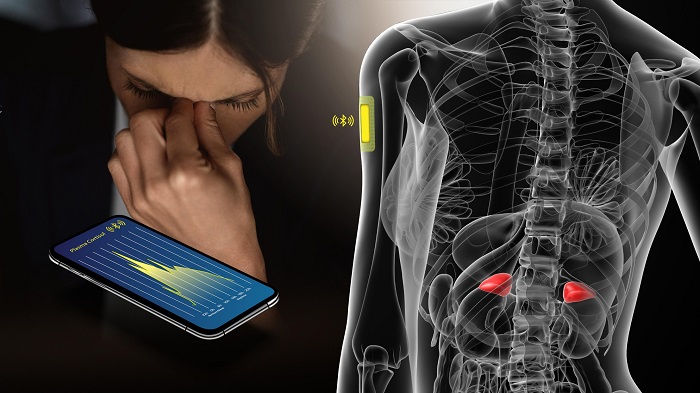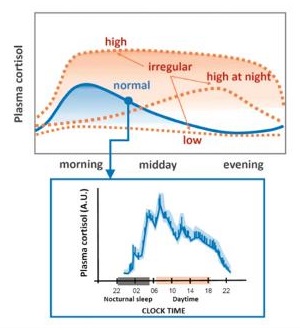We’ve all felt stressed at some point, whether in our personal or professional lives or in response to exceptional circumstances like the COVID-19 pandemic. But until now there has been no way to quantify stress levels in an objective manner.
That could soon change thanks to a small wearable sensor developed by engineers at EPFL’s Nanoelectronic Devices Laboratory (Nanolab) and Xsensio. The device has the potential to be placed directly on a patient’s skin in a wearable patch and, in the future, to quasi-continually measure the concentration of cortisol, the main stress biomarker, in the patient’s sweat.

Cortisol: A double-edged sword
Cortisol is a steroid hormone made by our adrenal glands out of cholesterol. Its secretion is controlled by the adrenocorticotropic hormone (ACTH), which is produced by the pituitary gland. Cortisol carries out essential functions in our bodies, such as regulating metabolism, blood sugar levels and blood pressure; it also affects the immune system and cardiovascular functions.
When we’re in a stressful situation, whether life-threatening or mundane, cortisol is the hormone that takes over. It instructs our bodies to direct the required energy to our brain, muscles and heart. “Cortisol can be secreted on impulse – you feel fine and suddenly something happens that puts you under stress, and your body starts producing more of the hormone,” says Adrian Ionescu, head of Nanolab from the School of Engineering.
While cortisol helps our bodies respond to stressful situations, it’s actually a double-edged sword. It’s usually secreted throughout the day according to a circadian rhythm, peaking between 6am and 8am and then gradually decreasing into the afternoon and evening. “But in people who suffer from stress-related diseases, this circadian rhythm is completely thrown off,” says Ionescu. “And if the body makes too much or not enough cortisol, that can seriously damage an individual’s health, potentially leading to obesity, cardiovascular disease, depression or burnout.”

Qualitative depiction of regular and irregular circadian levels throughout the day.
Capturing the hormone to measure it
Blood tests can be used to take snapshot measurements of patients’ cortisol levels. However, detectable amounts of cortisol can also be found in saliva, urine and sweat. Ionescu’s team at Nanolab decided to focus on sweat as the detection fluid and developed a wearable smart patch with a miniaturized sensor.
The patch contains a transistor and an electrode made from graphene which, due to its unique proprieties, offers high sensitivity and very low detection limits. The graphene is functionalized through aptamers, which are short fragments of single-stranded DNA or RNA that can bind to specific compounds. The aptamer in the EPFL patch carries a negative charge; when it comes into contact with cortisol, it immediately captures the hormone, causing the strands to fold onto themselves and bringing the charge closer to the electrode surface. The device then detects the charge, and is consequently able to measure the cortisol concentration in the wearer’s sweat.
So far, no other system has been developed for monitoring cortisol concentrations continuously throughout the circadian cycle. “That’s the key advantage and innovative feature of our device. Because it can be worn, scientists can collect quantitative, objective data on certain stress-related diseases. And they can do so in a non-invasive, precise and instantaneous manner over the full range of cortisol concentrations in human sweat,” says Ionescu.
Engineering improved healthcare
The engineers tested their device on Xsensio’s proprietary Lab-on-SkinTM platform; the next step will be to place it in the hands of healthcare workers. Esmeralda Megally, CEO of Xsensio, says: “The joint R&D team at EPFL and Xsensio reached an important R&D milestone in the detection of the cortisol hormone. We look forward to testing this new sensor in a hospital setting and unlocking new insight into how our body works.” The team has set up a bridge project with Prof. Nelly Pitteloud, chief of endocrinology, diabetes and metabolism at the Lausanne University Hospital (CHUV), for her staff to try out the continuous cortisol-monitoring system on human patients.
These trials will involve healthy individuals as well as people suffering from Cushing’s syndrome (when the body produces too much cortisol), Addison’s disease (when the body doesn’t produce enough) and stress-related obesity. The engineers believe their sensor can make a major contribution to the study of the physiological and pathological rhythms of cortisol secretion.

Process flow for capturing cortisol with the graphene electrode and aptamers.
So what about psychological diseases caused by too much stress? “For now, they are assessed based only on patients’ perceptions and states of mind, which are often subjective,” says Ionescu. “So having a reliable, wearable sensor can help doctors objectively quantify whether a patient is suffering from depression or burnout, for example, and whether their treatment is effective. What’s more, doctors would have that information in real time. That would mark a major step forward in the understanding of these diseases.” And who knows, maybe one day this technology will be incorporated into smart bracelets. “The next phase will focus on product development to turn this exciting invention into a key part of our Lab-on-SkinTM sensing platform, and bring stress monitoring to next-generation wearables,” says Megally.
The research results were published in the journal Communications Materials.
Read the original article on École polytechnique fédérale de Lausanne (EPFL).
